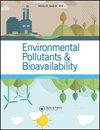不同镉供应条件下玉米的生长、生理反应及对镉的吸收
Q3 Chemical Engineering
引用次数: 41
摘要
摘要研究了不同Cd胁迫下Cd对玉米(Zea mays L.)生长和吸收Cd的影响。结果表明,在Cd供应水平≤100 μmol l−1的营养液条件下,植株的茎部和根部干物质产量均未降低;随着外源Cd水平的增加,玉米茎部和根系的Cd浓度急剧上升,最高可达50 μmol l−1,随后随着Cd水平的进一步增加而缓慢下降,这是由于Cd对根系生长的毒性作用。玉米叶片叶绿素a、叶绿素b和叶绿素a + b浓度随外源Cd水平的增加而缓慢下降。外源Cd影响下玉米脯氨酸浓度升高。低浓度Cd处理对玉米生长无显著影响,反而增加了玉米对Cd的吸收;高浓度Cd处理引起玉米生理反应,降低了玉米对Cd的吸收。本文章由计算机程序翻译,如有差异,请以英文原文为准。
Growing, physiological responses and Cd uptake of Corn (Zea mays L.) under different Cd supply
Abstract The effects of Cd on the growth and Cd uptaking in corn (Zea mays L.) were explored under different Cd stress. The results showed that no reduction in shoot and root dry matter yields were noted when the plants were grown at Cd supply levels ≤100 μmol l−1 nutrient solution. The Cd concentration in the shoots and roots of corn increased sharply with increasing external Cd supply levels, peaked at 50 μmol l−1, and then decreased slowly with further increasing Cd levels due to high Cd toxic effects on root growth. The concentrations of chlorophyll a, chlorophyll b and chlorophyll a + b in the leaf of corn decreased slowly with increasing external Cd supply levels. Proline concentrations of corn increased when the plants were grown under the external Cd influence. The lower concentration of Cd treatments did not influenced the growth of corn significantly, and increased the uptake of Cd, the higher levels of Cd supply caused significantly physiological resposes and decreased the Cd uptaking.
求助全文
通过发布文献求助,成功后即可免费获取论文全文。
去求助
来源期刊
CiteScore
1.62
自引率
0.00%
发文量
0
审稿时长
1 months
期刊介绍:
Chemical Speciation & Bioavailability ( CS&B) is a scholarly, peer-reviewed forum for insights on the chemical aspects of occurrence, distribution, transport, transformation, transfer, fate, and effects of substances in the environment and biota, and their impacts on the uptake of the substances by living organisms. Substances of interests include both beneficial and toxic ones, especially nutrients, heavy metals, persistent organic pollutants, and emerging contaminants, such as engineered nanomaterials, as well as pharmaceuticals and personal-care products as pollutants. It is the aim of this Journal to develop an international community of experienced colleagues to promote the research, discussion, review, and spread of information on chemical speciation and bioavailability, which is a topic of interest to researchers in many disciplines, including environmental, chemical, biological, food, medical, toxicology, and health sciences.
Key themes in the scope of the Journal include, but are not limited to, the following “6Ms”:
Methods for speciation analysis and the evaluation of bioavailability, especially the development, validation, and application of novel methods and techniques.
Media that sustain the processes of release, distribution, transformation, and transfer of chemical speciation; of particular interest are emerging contaminants, such as engineered nanomaterials, pharmaceuticals, and personal-care products.
Mobility of substance species in environment and biota, either spatially or temporally.
Matters that influence the chemical speciation and bioavailability, mainly environmentally relevant conditions.
Mechanisms that govern the transport, transformation, transfer, and fate of chemical speciation in the environment, and the biouptake of substances.
Models for the simulation of chemical speciation and bioavailability, and for the prediction of toxicity.
Chemical Speciation & Bioavailability is a fully open access journal. This means all submitted articles will, if accepted, be available for anyone to read, anywhere, at any time. immediately on publication. There are no charges for submission to this journal.

 求助内容:
求助内容: 应助结果提醒方式:
应助结果提醒方式:


